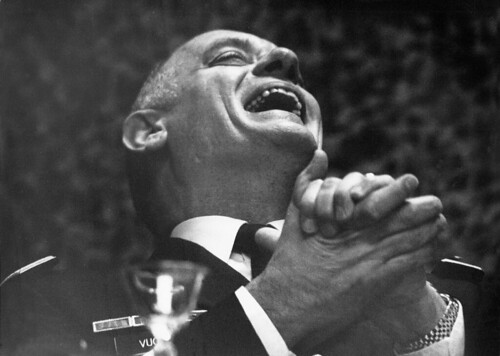Oscar Mayer Hotdoggers Anggela "Angie Dogg" Pimentel Warstonh and Kevin "Bacon Bits" Jacobsen, far right, discuss the company's Wienermobile Friday with visitors Mike Runyon, second from left, and Lenny Gregg at a new Walmart in West Brownsville, Pa. (Scott Beveridge/Observer-Reporter)
By Scott Beveridge
WEST BROWNSVILLE, Pa. – Talk about a great job opportunity for a new college graduate, especially one who majored in communications or marketing.
Each June the Madison, Wisc.-based Oscar Mayer hires a new pool of new drivers known as hotdoggers to split up and travel around the United States in six large trucks, each shaped like a giant hot dog parked on a lightly toasted bun, to promote the company.
"We'll be riding down the road - we get waves, smiles and friendly hugs," said Kevin "Bacon Bits" Jacobsen of Philadelphia, a recent graduate of Pennsylvania State University.
"We get to travel a lot, meet interesting people, and, we drive the Oscar Mayer Wienermobile. That's the best part of the job," added Anggela C. "Angie Dogg" Pimentel Warstonh of Miami, Fla.
These hotdoggers were traveling around Pittsburgh this week, and stopped Friday outside a new Walmart store along Route 40 in West Brownsville, Pa.
"How much does it weigh?" asked Mike Runyan of nearby Daisytown, when he walked up to admire the truck's wheels.
Runyan learned it weighs 7 tons, "which is pretty heavy," he said.
It also has a V-8 engine that runs on pretend "high-octane mustard."
"It's awesome," he said.
Earlier Chatty Tinsley of Brownsville walked up to the bright yellow and orange Fiberglass vehicle atop a 2009 Chevy chassis with her 4-year-old daughter, Jackquari Tarpley.
"I love it because it's cool," Tinsley said. "We love Oscar Mayer wieners."
A recording of the company's well-known jingle softly plays while Warstorh and Jacobsen pass out free whistles, sticker and coupons to visitors.
This job lasts just one year, after these drivers complete training over two weeks in Wisconsin at "Hot Dog High" to learn how to drive the 27-foot truck, and it will look good on any new job-seeker's resumé.
"Finding a parking spot. It's not that easy," Warstonh said of the vehicle, which measures 8 feet wide and has a hot dog-shaped dashboard.
There is a fake squirt of mustard in its carpeting design and blue sky art on its ceiling.
With their job here in West Brownsville completed, the two were heading out next to Penn State to recruit new Hoddoggers.
Chatty Tinsley and her daughter, Jackquari Tarpley, 4, of Brownsville, get a kick out of the Oscar Mayer Wienermobile after it pulled up Friday to a new Walmart in the area. (Scott Beveridge/Observer-Reporter)
By Scott Beveridge
WEST BROWNSVILLE, Pa. – Talk about a great job opportunity for a new college graduate, especially one who majored in communications or marketing.
Each June the Madison, Wisc.-based Oscar Mayer hires a new pool of new drivers known as hotdoggers to split up and travel around the United States in six large trucks, each shaped like a giant hot dog parked on a lightly toasted bun, to promote the company.
"We'll be riding down the road - we get waves, smiles and friendly hugs," said Kevin "Bacon Bits" Jacobsen of Philadelphia, a recent graduate of Pennsylvania State University.
"We get to travel a lot, meet interesting people, and, we drive the Oscar Mayer Wienermobile. That's the best part of the job," added Anggela C. "Angie Dogg" Pimentel Warstonh of Miami, Fla.
These hotdoggers were traveling around Pittsburgh this week, and stopped Friday outside a new Walmart store along Route 40 in West Brownsville, Pa.
"How much does it weigh?" asked Mike Runyan of nearby Daisytown, when he walked up to admire the truck's wheels.
Runyan learned it weighs 7 tons, "which is pretty heavy," he said.
It also has a V-8 engine that runs on pretend "high-octane mustard."
"It's awesome," he said.
Earlier Chatty Tinsley of Brownsville walked up to the bright yellow and orange Fiberglass vehicle atop a 2009 Chevy chassis with her 4-year-old daughter, Jackquari Tarpley.
"I love it because it's cool," Tinsley said. "We love Oscar Mayer wieners."
A recording of the company's well-known jingle softly plays while Warstorh and Jacobsen pass out free whistles, sticker and coupons to visitors.
This job lasts just one year, after these drivers complete training over two weeks in Wisconsin at "Hot Dog High" to learn how to drive the 27-foot truck, and it will look good on any new job-seeker's resumé.
"Finding a parking spot. It's not that easy," Warstonh said of the vehicle, which measures 8 feet wide and has a hot dog-shaped dashboard.
There is a fake squirt of mustard in its carpeting design and blue sky art on its ceiling.
With their job here in West Brownsville completed, the two were heading out next to Penn State to recruit new Hoddoggers.
Chatty Tinsley and her daughter, Jackquari Tarpley, 4, of Brownsville, get a kick out of the Oscar Mayer Wienermobile after it pulled up Friday to a new Walmart in the area. (Scott Beveridge/Observer-Reporter)





